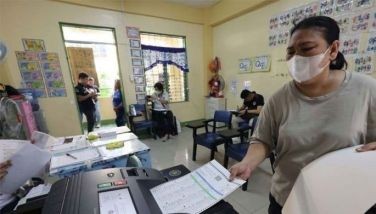Drones aren’t just for fun
MANILA, Philippines – A technology startup founded by science and engineering students at Ateneo De Manila University is now piloting its use cases for science and other projects with social impact.
Drones, flown to take aerial photographs or videos, are fun. Film companies and production houses are increasingly using them in movies or documentaries – think high-flying car chases a la James Bond or stunning vistas of the wild in places difficult to reach by foot.
And then there were the eternal Peter Pans who never outgrew their fascination for their flying toys or mini radio-controlled helicopters and decided to go big time with the more expensive drones, which civil aviation authorities now classify as unmanned aircraft vehicles (UAVs).
But drones, also referred to as remotely piloted aircrafts (RPAs), aren’t just for fun. Think surveillance, disaster mitigation, environment monitoring, aerial mapping, or structure inspection, for which drones are useful and ubiquitous.
A technology startup founded by science and engineering students at Ateneo De Manila University is now piloting its use cases for science and other projects with social impact.
“Drones are great, but we want to focus on day-to-day applications like how we use drones to make places more efficient and safe,” says Matthew Cua, chief executive officer of Skyeye, who was a speaker at the Geeks On a Beach (GOAB) Conference held in Boracay recently.
The Skyeye website says that the original team that founded Skyeye after typhoon Ondoy in 2009 toyed with the idea that drones can be used as a support tool for disaster analysis and response. Today, its services span a whole gamut of applications that can give local government units or agencies the tools they need for decision making.
Aerial mapping and disaster post-mortem
One of Skyeye’s aerial mapping projects involves a multi-disciplinary collaboration to map the fish pens at Lake Palikpikan in San Pablo, Laguna.
The area, which covers some 43 hectares with a depth of around 7.5 meters, was one of San Pablo’s seven crater lakes. Fishpens and fish cages provide a livelihood to the people, however, the area was also hounded by disputes.
Using UAVs, Skyeye plotted all the fish pens and identified their owners. “We found out that 30 per cent of the fish pen owners were not even there. By removing the abandoned fish pens, they were able to reduce fish kills. The community was able to rearrange the area to include boardwalks and protected areas,” Cua says.
After super typhoon Yolanda in 2013, Skyeye was also commissioned to map entire municipalities affected by the storm surge to estimate damage to crops, particularly coconut trees.
“Through aerial mapping, we estimated the number of coconut trees destroyed by the typhoon. Each tree was also analyzed and identified through computer vision. From the map, we estimated how much the government needs to spend to uproot the fallen trees,” Cua shares.
In February 2012, the town of Javier, Leyte was hit by major flooding, ahead of Yolanda’s fury. Aerial images taken by UAVs showed that the landslide stopped short of the house of the chief of police, giving the mayor a picture of the scale of the landslide.
Other projects it has done for the government include mapping a section of Lake Caliraya through the National Power Corp. for watershed protection, and a mangrove mapping and restoration project with the United Nations World Food Program and Cagayan State University.
Skyeye is also involved in several road-building and infrastructure projects of the government.
“Traditionally, before you build a road, you have to put a surveyor, estimate right of way, and purchase the land. It takes a long time,” he says. “We map the area before the road is built, plot all land titles, and using the map, talk to landowners and farmers to convince them about the benefits of having a road constructed near their property.”
Skyeye says in its website that working with partners like the Manila Observatory and the UP National Institute of Geological Survey, the company continues to work to make organizations or communities more disaster-resilient.
Its solutions include risk assessment through aerial mapping and digital elevation mapping, and on-call UAV rapid-response to give rescue workers and organizations an “eye-in-the-sky” as quickly as the disaster happens.
Proliferation and regulation
As more Filipinos are discovering the fun of flying drones as a hobby or simply for recreation, the regulation of UAVs for public safety are coming into focus.
Capt. Manuel Foronda of the Civil Aviation Authority of the Philippines (CAAP) explained at the GOAB conference that with the price of drones now becoming more affordable and with multiple use cases, it is important for the government to step in to craft regulations on drone use and management for the safety and security of the general public.
“These devices can be bought beginning at $200 and can be used for multiple purposes, both legal and illegal,” he says, “We would like to propagate its beneficial use but in a regulatory environment of utility and propriety.”
Foronda explains that even the International Civil Aviation Organization, a UN specialized agency created in 1944, noted that the integration of drones into the non-segregated airspace covered by air traffic management raises diverse issues such as licensing, medical qualifications of remote pilots, technology for sense and avoidance system, radio frequency spectrum, including protection from interference and the development of a regulatory framework.
Under Philippine laws, UAVs must be registered and their operators or controllers must be licensed to fly the aircraft. There are also restrictions imposed on flying small or large UAVs at night, in populous areas, at certain heights, and in controlled airspaces.
Foronda, however, says that the guidelines are under review and a new one may be issued by the last quarter of the year.
An informal interview with the local supplier of drones at the sidelines of GOAB reveals that an estimated 2,000 drones are sold locally per year, mostly to hobbyists, enthusiasts, researchers, photographers, production houses and media companies.
One of the more affordable drones for beginners available locally is the DJI Phantom 3 Standard, which is even available for purchase on Lazada.
Foronda says CAAP expects the continued proliferation of these devices in the coming years, thus its interest to update the regulations that would keep up with industry developments. The goal, he says, is not to kill the fun and enthusiasm for the new technology, but to promote “responsible flying”.
- Latest

























